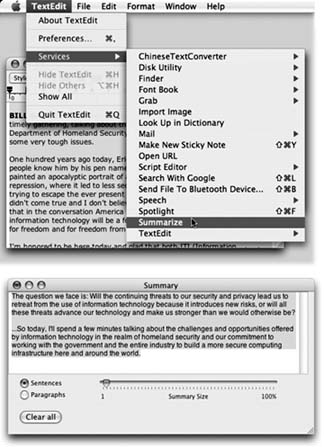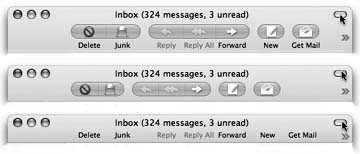5.9. The Cocoa Difference
| < Day Day Up > |
| Here are some of the advantages Cocoa programs offer. It's worth readingnot to make you drool about a future when all Mac programs will fall into this category, but to help clear up any confusion you may have about why certain features seem to be present only occasionally. Note: The following features appear in almost all Cocoa programs. That's not to say that you'll never see these features in Carbonized programs; the occasional Carbon program may offer one of these features or another. That's because programmers have to do quite a bit of work to bring them into Carbon applicationsand almost none to include them in Cocoa ones. 5.9.1. The Font PanelThe Mac has always been the designer's preferred computer, and Mac OS X only strengthens its position. For one thing, Mac OS X comes with about 100 absolutely beautiful fonts that Apple licensed from commercial type companiesabout $1,000 worth, according to Apple. When you use a Carbon program, you usually access these fonts the same way as always: using a Font menu. But when you use a Cocoa program, you get the Font panel, which makes it far easier to organize, search, and use your font collection. Chapter 14 describes fonts, and the Font panel, in more detail. 5.9.2. Title Bar Tricks You may remember from Chapter 2 that the title bar of every Finder window harbors a secret pop-up menu. When you In Cocoa programs, you get the same features in document windows , as shown back in Figure 2-5 (Section 2.4.2). (This feature is available in many Carbonized programs, but it isn't a sure thing.) By dragging the tiny document icon next to the document's name, you can perform these two interesting stunts:
Unfortunately , you can't drag an open document directly into the Trasha technique that could come in handy for writers who struggle with first drafts. 5.9.3. ServicesApple has always dreamed of a software architecture that would let you mix and match features from different programsusing the AppleWorks spell checker in Microsoft Word, the drawing tools of PowerPoint in your email program, and so on. (Remember Apple's OpenDoc software project? Neither does anybody else.) In Mac OS X, Apple's dream has finally become a reality. Nestled in the Application menu of almost every Mac OS X program is a command called Services. Its submenu lists several functions that technically belong to other programs, as described below. Unfortunately, these commands are dimmed when you use most Carbonized programs (like AppleWorks, Photoshop, and Microsoft Office). They become available only when you use Cocoa programs like iChat, TextEdit, Mail, OmniWeband the Finder. (Yes, the Finder is a Carbon program. But remember that programmers can add Cocoa features to their older, Carbonized programs; it just takes a lot of work.) Here's a summary of what they do. Note: Not all of these Services work in all programseven Cocoa programs. (iPhoto doesn't, for example.) Implementing them is left to programmers' discretion. A little unpredictability along these lines is par for the course. 5.9.3.1. ChineseTextConverterTalk about obscure: This utility, new in Tiger, converts selected text that you've written in Chinese using its Simplified text system into the Chinese Traditional text systemor vice-versa. Let the celebration begin! 5.9.3.2. Disk UtilityHere's another new Service that everyday Mac fans haven't exactly been clamoring for. This one lets software programmers and system administrators check to make sure that the disk image files they've created (Section 5.10.2) haven't been altered without even having to double-click and "mount" the disk image. 5.9.3.3. FinderThe three commands listed in this submenu work in only one situation: When you've highlighted some text that precisely matches the name and folder path of any icon, such as ~/ Documents/Marge.jpg . (Details on path notation on Section 1.2.2.) At that point, you can choose any of these commands from the Services
If what you've highlighted isn't the name and path of a document, you'll get only an error message. 5.9.3.4. Font BookFont Book, as you can read in Chapter 14, is a font-managing program. Among other talents, it can clump your fonts into Collections ( subsets of your choice) or Libraries (collections of Collections). These Service commands generate a whole collection or library of fonts contained in one document (whatever's on the screen at the time). Begin by highlighting the text that uses the fonts (usually you'll want the whole document). Then choose Services The payoff comes when you want to submit the document to, for example, a graphics shop for professional printing, or to someone who'll be editing your work on a different computer. Font Book can easily export a collection of fonts (File 5.9.3.5. Grab Grab is a screen-capture program in your Applications The Grab service, in theory, lets you take your software snapshot from within any Cocoa application, without having to go find and launch Grab separately; unfortunately, it's available only in programs that can accept pasted graphics. You'll find details on Grab's submenu commands (Screen, Selection, Timed Screen) on Section 10.26.10.3. 5.9.3.6. Import ImageThis option lets you import a digital photo from a scanner or digital camera, if one is attached and ready to roll. Like Grab, it works only in Cocoa programs that accept pasted graphics, and like Image Capture (on which it's based), it can operate only Web-cammable digital cameras and compatible scanners (see Section 10.12.5). 5.9.3.7. Look Up in DictionaryHere's yet another way to access the new Tiger Dictionary program. Highlight a word, choose this command, and presto: the Dictionary program opens automatically and proudly presents a definition for your enlightenment. (There are easier, more universal ways to look up words in Tiger, as described on Section 10.7.) 5.9.3.8. MailThis handy command springs to life only after you've highlighted some text in a Cocoa programor a file in the Finder.
5.9.3.9. Make New Sticky Note This command copies whatever text you've got highlighted, switches to your Stickies program (Section 10.23.1), creates a new sticky note, and pastes your selected material in it. If you're the kind of person who keeps your lifelists, passwords, favorite URLs, to-do list, notes, and so onin Stickies, this one can save you considerable hassle. No wonder Apple endowed it with its own keyboard shortcut: Shift- 5.9.3.10. Open URLWhen you highlight a Web address in any program, choosing this command fires up your Web browser and takes you to the indicated page. 5.9.3.11. Script EditorFor AppleScript fans only (Chapter 8).
None of these Script Editor services do any error checking. If you forget a quotation mark in your script, it simply won't run. Tip: If you know how to use the do shell script command, you can run Unix commands directly from your service-enabled programs (see Chapter 16). 5.9.3.12. Search with GoogleNever let it be said that inspiration is dead in the post-tech-bubble era. This unassuming command adds a powerful research assistant to every program where you can type. Highlight a phrase Picasso, electric curtains, Yankees game and hit this command. In seconds, you're online, in your Web browser, facing a list of Web pages from a Google search for that topic. It's a dictionary, thesaurus, news service, and stock ticker all in one. The gang at Apple loves this one, too. They blessed it with its own keyboard shortcut: Shift- 5.9.3.13. Send File to Bluetooth DeviceBluetooth is a short-range, wireless, cable- elimination technology. It's great for tossing files between two Macs (or a Mac and a Windows laptop, for that matter), on the fly, on a plane, without any cables or setup. (Your Mac must have a Bluetooth transmitter, of course. All current PowerBooks do, for example.) If you've highlighted the path of a file (see the tip below), this command grabs the file and hands it off to Bluetooth File Exchange, which begins the process of transmitting it to a nearby Bluetooth computer. (Section 7.2.5 describes this ritual .) 5.9.3.14. SpeechAs detailed in Chapter 15, Mac OS X doesn't just display text onscreenit can actually read it out loud.
Tip: If you highlight an icon in the Finder, the Start Speaking Text command reads its path to you. For example, for a Flowers.tif file in your Home  Pictures folder, whose path is Users/chris/Pictures/Flowers.tiff , the Mac says, "Users, Chris, Pictures, Flowers dot tiff." Pictures folder, whose path is Users/chris/Pictures/Flowers.tiff , the Mac says, "Users, Chris, Pictures, Flowers dot tiff." 5.9.3.15. Spotlight As you know from Chapter 3, Spotlight is always at your command, ready to find files, folders, or programs at the touch of a key. But the 5.9.3.16. SummarizeTalk about intriguing: When you choose this command after highlighting some text, the Mac analyzes the sentences you've highlighted and, after a moment, launches Summary Service. This little program, which you probably never even knew you had, displays a greatly shortened version of the original text. Figure 5-16 offers details. Tip: To save the summarized document as a TextEdit document, choose File  Save As. Save As. TextEdit  Open Selected File to find and open that document in TextEdit. (If what youve highlighted isn't the name of a document, you'll get only an error message.) Open Selected File to find and open that document in TextEdit. (If what youve highlighted isn't the name of a document, you'll get only an error message.)
Although these are the commands that come built into a fresh installation of Mac OS X, that's not the end of the versatility. The real beauty of Services is that as new, clever applications come along, they can add their own commands to this menu for your data-manipulation pleasure. Tip: InstantLinks, a piece of $5 shareware from Subsume Technologies, offers a useful look ahead to the future of Services. It adds commands to your Services menu that send your highlighted text to various services on the Web.For example, you can choose Dictionary Lookup (looks up the selected text in an online dictionary), Map Location (looks up the selected address at MapQuest.comgreat when somebody emails you an invitation ), Open URL, Search Web, and Thesaurus Lookup. You can download it from the "Missing CD" page of www.missingmanuals.com. 5.9.4. Toolbar TricksThe toolbar is an increasingly common sight at the top of modern application windows. In any thoughtfully written program, the Customize Toolbar command lets you determine how you want this toolbar to show upwith icons, as icons with text labels beneath them, with text labels alone to save window space, and so on. But in many Cocoa programsincluding OmniWeb, Mail, Address Book, and Xcodethere's a much faster way to switch among these toolbar styles: Just
5.9.5. Secret Keyboard ShortcutsFor the most part, it's possible to ignore the Unix that beats within the heart of Mac OS X. But every now and then, a refreshing reminder pokes its head up through the fields of brushed metaland here's one of them. Although you'll never see it mentioned in the user manuals for Cocoa applications (if there even were such things as user manuals anymore), most of them respond to certain keystrokes left over from the NeXT operating system (Mac OS X's ancestor ). If you're a card-carrying number of KIAFTMA (the Keyboard Is Always Faster Than the Mouse Association), you'll love these additional keyboard navigation strokes:
Four additional keystrokes duplicate the functions of the arrow keys. Still, as long as you've got your pinky on that Control key
5.9.6. Cool Text-Selection TricksBy holding down certain keys while dragging through text in a Cocoa program, you gain some wild and wacky text-selection powers. (You'll find them especially useful in, for example, TextEdit and Pages.) For example:
Tip: In most Cocoa programs, you can combine these two tricks. That is, you can select multiple, arbitrary (not full-page-width) blocks of text by pressing both Option and 5.9.7. Background Window Control As hinted in Chapter 1, the In every case, the secret is simply to keep
|
| < Day Day Up > |
EAN: 2147483647
Pages: 506


